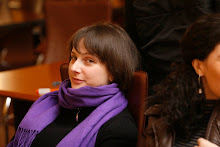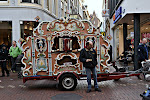
Contemporary Art Mixed by Hans Heiner Buhr
Sayatnova Street is one of the smallest streets in Old Sololaki district, where among the sinuous and extremely narrow streets you won’t be able to find Sayatnova easily or maybe never find. That’s the place where Hans Heiner Buhr lives. Very old wooden stairs go up to the house and a studio where the painter works. Hans Heiner Buhr is a painter. But this one word seems not enough to express all the diversity neither of his art nor his whole activities he is fond of doing.
The first Painting he shows is “Mother of Georgia” from his earlier works. He laughs a lot when remembers the first reaction of the Georgian who saw it on the exhibit. He shows me the real “Mother of Georgia” from the window of the studio “Are they alike?” he asks. It’s impossible to keep off laughing. Actually the painting shows an old woman sitting in the chair and two beardy men with guns are standing on the background of her. Their faces are stern, ruthless and they look like robbers. It is exactly what the painter wanted to express. It was Georgia perceived from his eye – eyes of a German man who came from Europe and find out a world of his childhood dreams. “All my childhood I played in robbery and pretended to be a thief or robber who lives wildly in the mountains and my dreams almost came true, I’d never imagine it,” remembers Buhr his first impressions about Georgia that actually last long, until this days.
“In 1996 I got a job as a German language teacher abroad. When people from the office asked me where I wanted to go I said South America. After some time they found me a workplace in Rustavi, Georgia. Of cause I’d heard about Georgia. I’m from East Germany, from East Berlin and I’ve studied eastern art and Russian language. I had some Russian friends and they used to talk much about Georgia and its beauty. When they heard about a chance I had, they advised not to miss the chance to explore a nice country and an opportunity to paint beautiful pictures,” Hans remembers. He arrived in Rustavi and probably astonished. He opened a completely bizarre country that he has never seen or heard.
Besides the extreme poverty, he saw a very strange, completely different transformation process of Georgia from socialism to capitalism apart different from the same transformation his home part of Germany, eastern Germany had been passing. “You had nobody, to advice what to do, Georgians had to learn themselves, I remember that time when Georgian women began their business, opened shops in Rustavi, when man used to spend time playing cards. Women were responsible on the family.” His “Mother of Georgia,” was an echo for that period when robbery and killing people had been considered as an ordinary thing in Georgia.

After seeing all this troubles and horrors in Georgia and still didn’t fled from the country, is makes clear how the romantic German painter felt in love with poor and dangerous but beautiful Georgia.
He stayed three years in Rustavi, using that period in traveling all over the country. Especially he was impressed with the mountains of east Georgia. Then he got married and has been living here about 13 years already having Georgian wife and three children, talking Georgian and German but looking like Germans. Now he is 43, tall and blond having greenish-bluish eyes and strong German accent.
“I stayed here and didn’t know what to do. I wanted to promote myself as an artist, because I was completely apart from Berlin and galleries, cultural life and I didn’t know what was going on there. Then I came across to blogs and I understood that it was a great thing to promote my art. I realized that blog was better than just web-site, and launched my blog.”
He is very fond of internet. He does most of his works using internet and is a great promoter of it.
“Internet is a kind of medium bringing together all Caucasian artists. Caucasus and Georgia had no lobby for a long time, nobody was interested in this country, but there are really good artists here, and foreign artist got interested what’s going on here, in Caucasian phenomena, its romantic character. There came an idea to create art club Caucasus, where we have gathered different artists from all over the world, including Georgian artists living abroad. That is not just only bringing them together but promotes them, we have their works on the site and viewer can see and buy them or contact with authors,“ Buhr says. The blog artclubcaucasus.blogspot.com is the place of one big gathering of the artists from Caucasus and people fond of the region with different styles, tastes and ways of expression.
The style of Hans Buhr is very eclectic, mix of painting, textile, photos, Photoshop and some more things and he merges them together with different techniques and methods. The style changes a lot. The latest idea he is obsesses is doing photo collages using silver paper as a background of the picture.
“Only problem that I faced was that my creations were only in computer and not in the paper, but I have found a way out of it, I found a special material, it is cheap and even if something pours on it, it doesn’t spoils and you can easily wash it. And people who like the picture can buy it, not just having in computer,” he even uses to paint with brush on the surface of the ready collage and create some different image of the picture.
Neighbor’s ordinary luxurious Mercedes treated in photoshop looks completely different and even it is hard to guess where the photo ends and painting begins, but there is no painting at all and that’s the whole charm of his works. They are very contemporary, very close to the reality but wrapped in a very romantic cover. Tin Solders are his other fascination. Black and Golden old soviet soldiers look very modern but giving the remembrance of old times as well.
In spite of his good skills in promotion, business, management and scheduling are words he doesn’t like. He performs his love to the traveling into a small business plus pleasure and enjoys it every summer. “I always try to take small groups to travel, because I don’t want to have real big business and I want to keep beauty in my business. Don’t want to become a manager and to sit on a table and write emails and manage the guests arrival. I can get more money to put 20 Americans in one big buss and bring them to kakheti and other places, but tourists and me, we are all much more satisfied when the group consists of two or three people, maximum 6.” His guests are mostly German, Austrian and Swiss tourists and the way he they connect with each other is again his invariable friend and partner – internet.
Hans has a good collection of paintings, Dutch and modern Georgian artists, who are his friends as well and is proud of his collection, the collection also consists of photos Stalin and big variety of maps exposed in the studio. His owns exposition intends to hold in October. Buhr has an amazing idea of the exhibit, but let live it as a surprise for the amateurs of the modern art.
Anna Chichinadze
http://www.georgiatoday.ge/article_details.php?id=6639&cat=Culture&version=455





 Intense colors of
Intense colors of 





